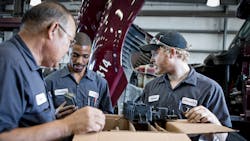Considering the wide range of parts from a variety of suppliers that a typical fleet uses on a daily basis, it shouldn’t be a surprise that providers and parts experts generally agree that effective management practices are a worthwhile and cost-effective investment.
“Fleets need to find someone who can put a strategic parts plan together to meet their company’s goals,” said Tyler Robertson, chief executive officer at Diesel Laptops. “Parts managers can pay for themselves many times over by finding ways to reduce costs and improve sourcing. They can consolidate purchasing programs and work with the service department to provide the appropriate level of quality parts.”
Jamie Irvine, host of The Heavy-Duty Parts Report, noted that having a dedicated parts manager is an asset, especially if a fleet maintains a large parts inventory. “There are many aspects to effective parts management,” he said. “Purchasing and meeting with suppliers are important practices, and proactively providing technicians with the parts they need leads to maximum efficiency in the shop.”
“Ensuring optimal efficiency in fleet parts programs starts with effective management,” stated Jim Calabro, fleet sales manager at Buy Wise Auto Parts. “We’ve found out among many fleets that when they have a parts manager, it works a lot better than having a working foreman handling parts needs, but who has other responsibilities as well.”
Any fleet with an in-house maintenance operation needs a full-time parts manager and an effective inventory management system, according to Bret Wilstead, senior director of national accounts at FleetPride. The most important thing a parts manager can do is take the time to set up a program with the right processes in place, he noted, and that includes using inventory management systems and making sure the input data is correct so that the data coming out will be accurate.
Sami Adlof, senior director of operations at FleetPride, also pointed out that committing to a parts manager dedicated to the service department helps in obtaining parts faster, which improves shop and technician productivity. Additionally, a service software platform that allows technicians to submit part requests electronically speeds up the procurement process.
Robertson noted the most efficient shops provide technicians the means to order parts electronically right from the bay. “The parts department would then source parts, communicate electronically with the technician, and bring the parts out to the bay,” he explained. “Even the minutes of time spent each day walking back and forth to a parts counter add up over the course of a year, so the savings with this process can be tremendous. This takes a lot of planning, communication, and implementation, but the rewards can be staggering.”
“The biggest thing to avoid is the time wasters, which come in multiple forms,” stated Irvine. “That includes everything from inventory systems that are inefficient to parts salespeople who tie you up in conversations that don’t add any value.
“Experimentation with inventory handling is important to address that issue,” Irvine continued. “For example, ask yourself how much time your fleet could save if you had commonly used parts stocked beside the tools of each technician rather than all your parts in one location. Reducing the number of steps each technician takes in a day will increase efficiency.”
Deliver value through supplier partnerships
A fleet parts manager should be responsible for not only finding cost-effective sourcing solutions, but in finding a partner that delivers strong overall value, related PACCAR Parts’ Scheel. “Even when a fleet maintains their own inventory, a local dealership may offer customized solutions to manage their parts needs,” he said.
“Another way fleets can ensure they get quality parts in a cost-effective manner is by enrolling in a national program from an OEM supplier,” Scheel added. “Fleets should be able to order parts across the country via a convenient, easy-to use ecommerce platform, and pay all parts invoices through one centralized system to streamline their payables process.
“Without those types of partnerships,” Scheel continued, “maintenance operations may pay a higher price for parts, which increases costs. Conversely, if they are focused solely on cost, then the fleet may not have a reliable parts distribution partner that carries a wide breadth and depth of all makes parts inventory, [which] can expedite parts and help keep trucks on the road.”
Fleets should consider partnering with a supplier, noted FleetPride’s Wilstead. “Providers build their operations with this in mind, including delivering access to a large inventory of parts, strategically located service centers, and experts whose aim is to help their customers get their vehicles running as quickly and as cost effectively as possible,” he said.
“Fleets like using suppliers that can consistently offer them everything they need, so we offer original equipment parts and aftermarket equivalents on many lines,” said Buy Wise Auto Parts’ Calabro. “Our main goal, regardless, is to make sure that the quality is always the best.”
He added that online ordering platforms are important to provide accessibility and transparency to inventory availability throughout the network.
“Don’t abdicate the management of your parts department; even if you use a vendor-managed inventory service, you must be responsible,” said Irvine. “Create a system that starts with ordering the part and ends with the part being installed on a truck or trailer. Don’t leave anything to chance and continuously strive for improvement. Make sound business decisions about what parts you purchase.”
Focus on total cost of operation
“Don’t focus on purchase price but rather on the impact a part has on your total cost of operation,” Irvine stated. “While it is often enticing to cherry pick promotions from multiple suppliers or pit one supplier against another in a price war, this doesn’t work in the long run.
“If you only focus on price, suppliers will sell you low-quality parts,” Irvine continued. “But the good feeling you have when you buy a part for the lowest price you’ve ever paid will quickly disappear when it fails prematurely and you have a towing bill, additional driver expenses, added repair costs, and lost revenue.”
Irvine also advised fleets to continually test parts and measure whether they ensure that they offer the lowest cost. “Technology is changing parts performance, so just because a part worked well before doesn’t mean it is still the best solution,” he said. “Trucks are also changing and depending on your vocation different specs may require different parts.”
“Sometimes it makes sense to put the most inexpensive part on a truck,” said Diesel Laptops’ Robertson. He cited equipment that may be retired soon as an example. “But the cheapest parts are often not the best parts for a fleet,” he noted. “It usually makes more sense to put higher quality parts on your vehicles and to look at total cost of ownership.”
Once those decisions are made, which brand to use is often asked next, Robertson said. “This process gets more complicated, but it can have a dramatic impact on a fleet’s bottom line,” he said.
“For example, in an inventory analysis for a large fleet with multiple shop locations, we found they were buying two different brands of wheel seals,” Robertson explained. “Both were from OEM-level manufacturers, and both carried the same warranty, but with the price variance across their organization one wheel seal was significantly cheaper. However, when you also looked at the quantity of wheel seals they were going through, the fleet could be spending over $13,000 more by purchasing the lower-cost item, and that was just one part number.
“Another example from a fleet was that they were not aware of aftermarket alternatives,” Robertson said. “In this case, they were purchasing an OEM coolant level sensor. A high-quality aftermarket manufacturer offered an alternative, which was 70% less expensive and also carried the same warranty. Switching this one part number on a low volume item saved the company $1,670 per year.”
Manage parts to maximize uptime
“It’s essential for suppliers to help fleets manage their parts needs,” stated Buy Wise Auto Parts’ Calabro. “At the same time, it is very important to manage inventory for vehicles, especially if they are decommissioned so the parts can be removed and new updated parts are put in place. The goal is always to maintain a balance of inventory for vehicles in the fleet.”
Not having parts available when equipment is scheduled for service can lead to even higher costs. “If a part that is supposed to be on the shelf is missing from inventory, it could cause a unit to be in the shop for an entire extra day and that has a direct impact on revenue and total cost of operation,” Irvine noted.
“Additionally, if a fleet has multiple repair locations and the parts are not managed correctly, you can easily end up with different quality parts being installed at one location from another,” he continued. “That impacts purchase price, cost-per-mile, and warranty eligibility.”
Irvine also pointed out that different parts sourcing strategies are needed dependent upon whether a fleet is a local, regional, or national operation and the number of repair locations.
“For a single location, you need a strong relationship with truck and trailer dealers and a local aftermarket supplier who can help you source high-quality parts,” he said. “Multiple location fleets need the same relationships with suppliers, but they need to be able to service you nationally, which can change the companies you choose to do business with to meet your parts needs.”
Measure the impact of effective parts programs
While cost considerations are important, Irvine suggested the most effective parts programs first prioritize product quality, cost-per-mile impact, supplier service, and availability.
“Additional labor and downtime will erode any cost savings that were achieved by purchasing parts that have a lower price due to lower quality,” Irvine said. “The best way to measure the success of a parts program is by measuring the impact it has on total cost of operation for a fleet.”
Effective parts management is critical for maximizing fleet uptime, as well as minimizing the total cost of ownership of trucks, advised PACCAR Parts’ Scheel. “Your success can be measured by a reduction in planned downtime if parts are available when they are needed,” he said. “An effective parts management program will also enable fleets to manage their total parts spend per truck at, or below, industry average levels.”
There are many variables that go into parts management, said Diesel Laptops’ Robertson. “You want to have not only the right parts on the shelf when you need them, but you also need to make sure you have the correct amount,” he added. “If you have too many, or the wrong parts, you have frozen capital. If you don’t have enough, and you are now spending company resources to find and source those parts, you’re slowing down the repair process.”
In general, a fleet should turn its inventory, by product line, around four times per year, according to Robertson. “Watching your inventory and looking at those metrics several times a year makes you drill down into each individual part,” he said. “You’ll often find you end up having to adjust quantity levels frequently. In the end, proper stocking and purchasing decisions of parts can easily reduce vehicle operating costs, improve uptime, and boost profitability.”
FleetPride’s Wilstead said fleets can realize better parts availability, consistent pricing, and quality control. “Your success can be measured in a variety of ways, including reduced downtime, less inventory, and lower parts spending,” he added.
Having a strong focus on managing parts and on having the right part at the right time is essential for driving uptime and profits, Wilstead added. “That can be done whether you are buying and stocking all the parts that your fleet may need or partnering with a truck parts supplier. The key is understanding that keeping heavy-duty trucks and trailers operating is critical to a trucking company's livelihood.”
About the Author

Seth Skydel
Seth Skydel, a veteran industry editor, has more than 36 years of experience in fleet management, trucking, and transportation and logistics publications. Today, in editorial and marketing roles, he writes about fleet, service, and transportation management, vehicle and information technology, and industry trends and issues.


